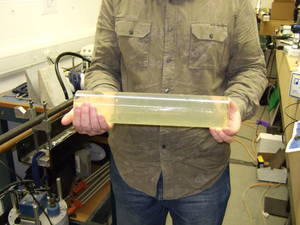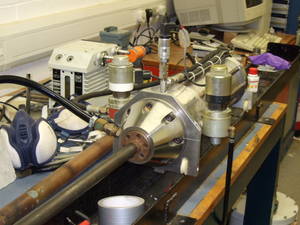How fat would you have to be to stop a bullet?
Ingredients
We went to the Cavendish Laboratory to discover how fat you would have to be to stop a bullet. We used a gas gun, which is basically a huge air rifle. There is a chamber that is filled with high pressure helium (this is used because it is lighter than air so will expand more quickly).
The gun has a 3m long barrel which you load a small ball bearing into. There is a valve between the chamber and the barrel which can be opened very quickly. The gas (at about 70 atmospheres) then expands extremely rapidly forcing the bullet out of the barrel at supersonic speeds.
|  |
| The gas chamber which is filled by high pressure helium | The bullet - a small steel ball bearing. |
A perspex tube was filled with gelatin, which is a similar density to fat, to act as the target.
 |  |
| The perspex tube full of gelatin to act as a target | This was mounted in front of a backstop full of rags. |
Result
A bullet hitting Gelatin
Explanation
 |
| First the gas in front of the bullet hits the gelatin |
 |
The bullet hits the gelatin at about 500m/s, that is over 1100mph - nearly twice the speed of sound! While the bullet is passing through the jelly it creates a conical shaped hole behind the bullet. This is because to get out of the way of the bullet the jelly has to move very fast, and once the bullet has passed it will keep moving in the same direction expanding into a cone. |
 |
| Bubbles form in front of the bullet, this would not happen in reality, it is because the perspex tube is stretched where the bullet hits it, and this stretch travels down the perspex as a wave faster than the bullet is moving, so the gelatin is stretched forming cavities. |
 |
| It all gets too much for the perspex which shatters. The bullet leaves the Gelatin at about 180m/s. This means that by a very rough approximation you would have to have twice this much fat to have stopped a supersonic bullet. That is 72cm of fat and is somewhat unfeasible, We think that bullet proof vests are probably more practical and probably cheaper! |
We have to say a huge thankyou to the Surface, Microstructure and Fracture Group at the Cavendish Laboratory. Particularly to David Williamson who set up the experiment for us despite his ridiculously busy schedule.
- Previous Coke Can Eruption
- Next White bread and the wonder of enzymes











Comments
Add a comment